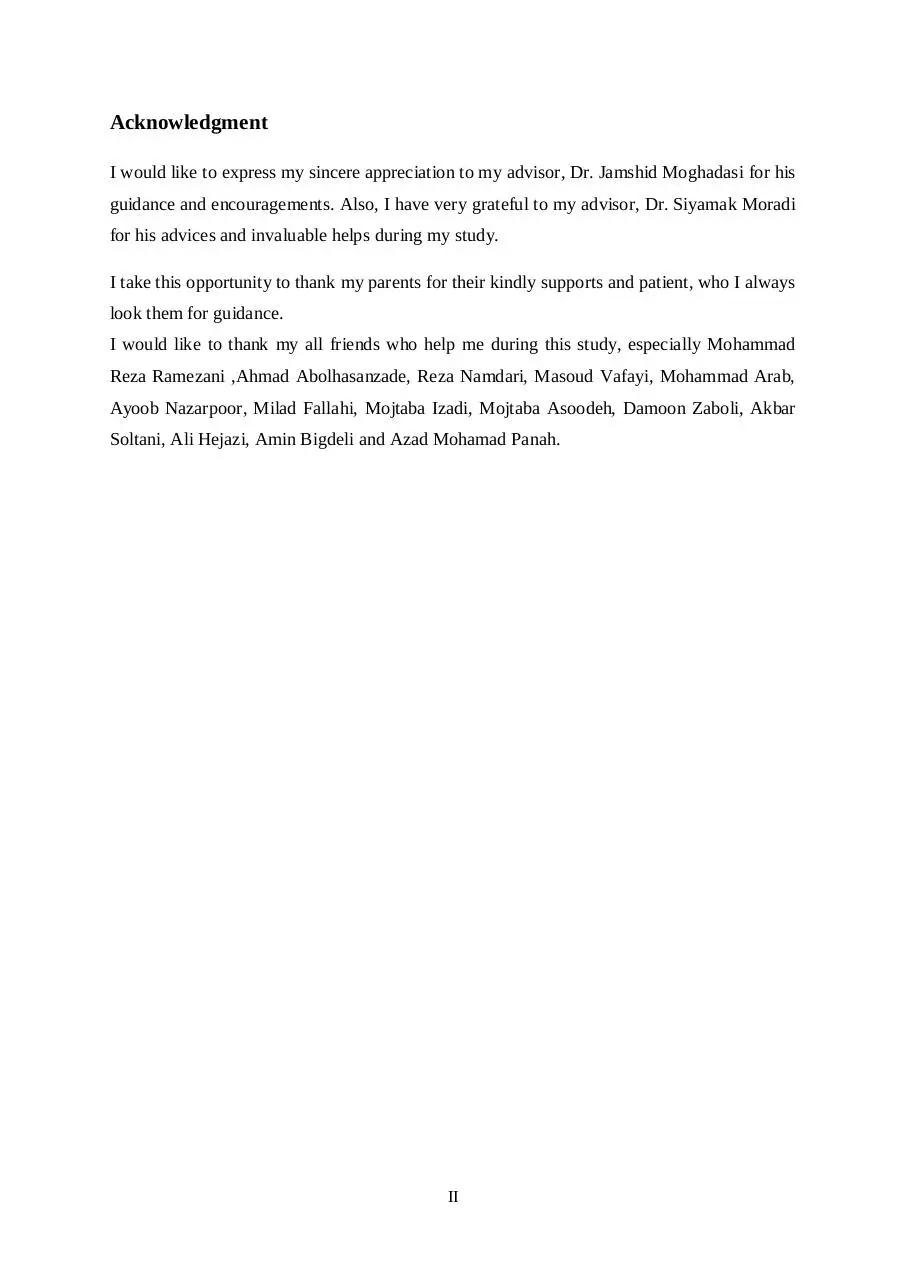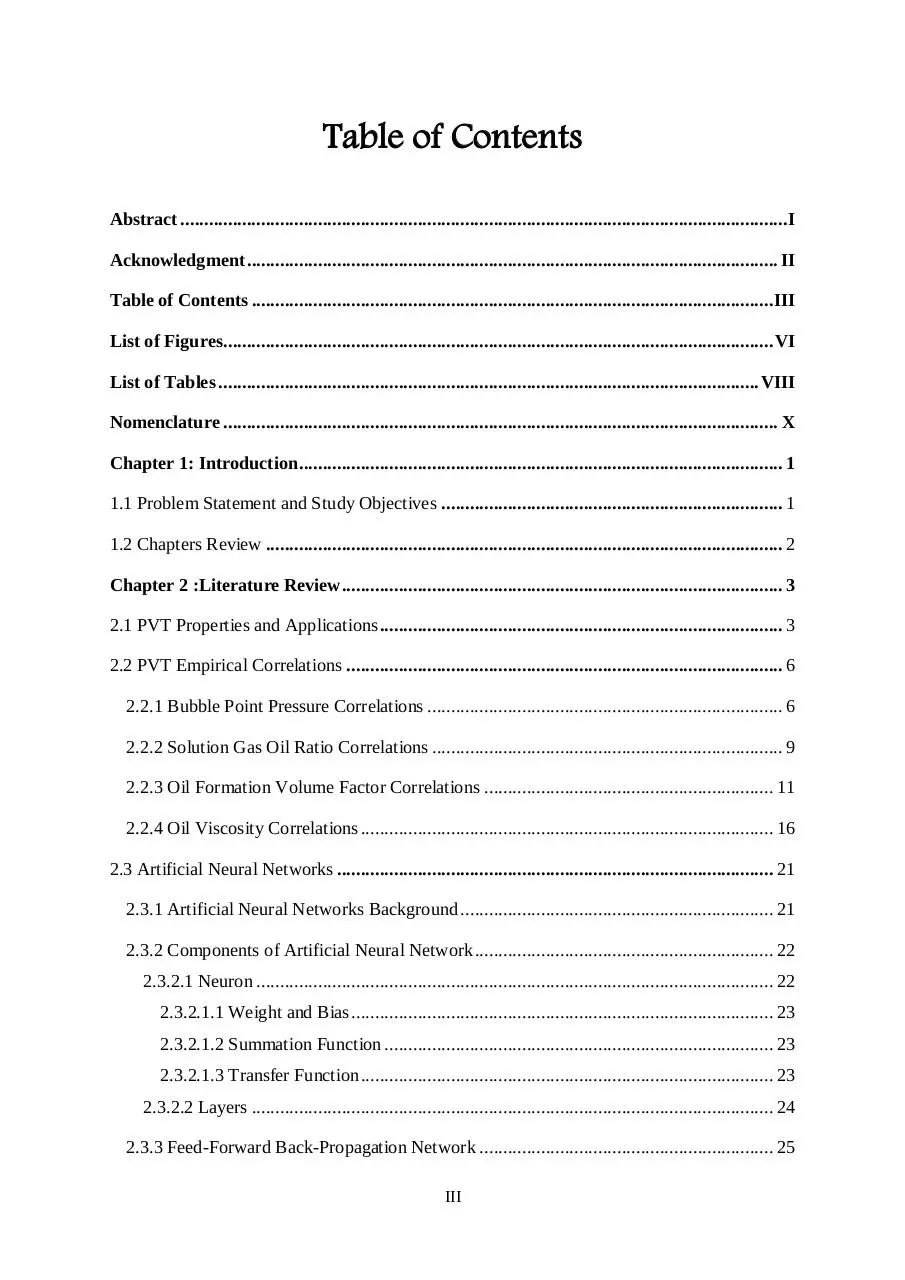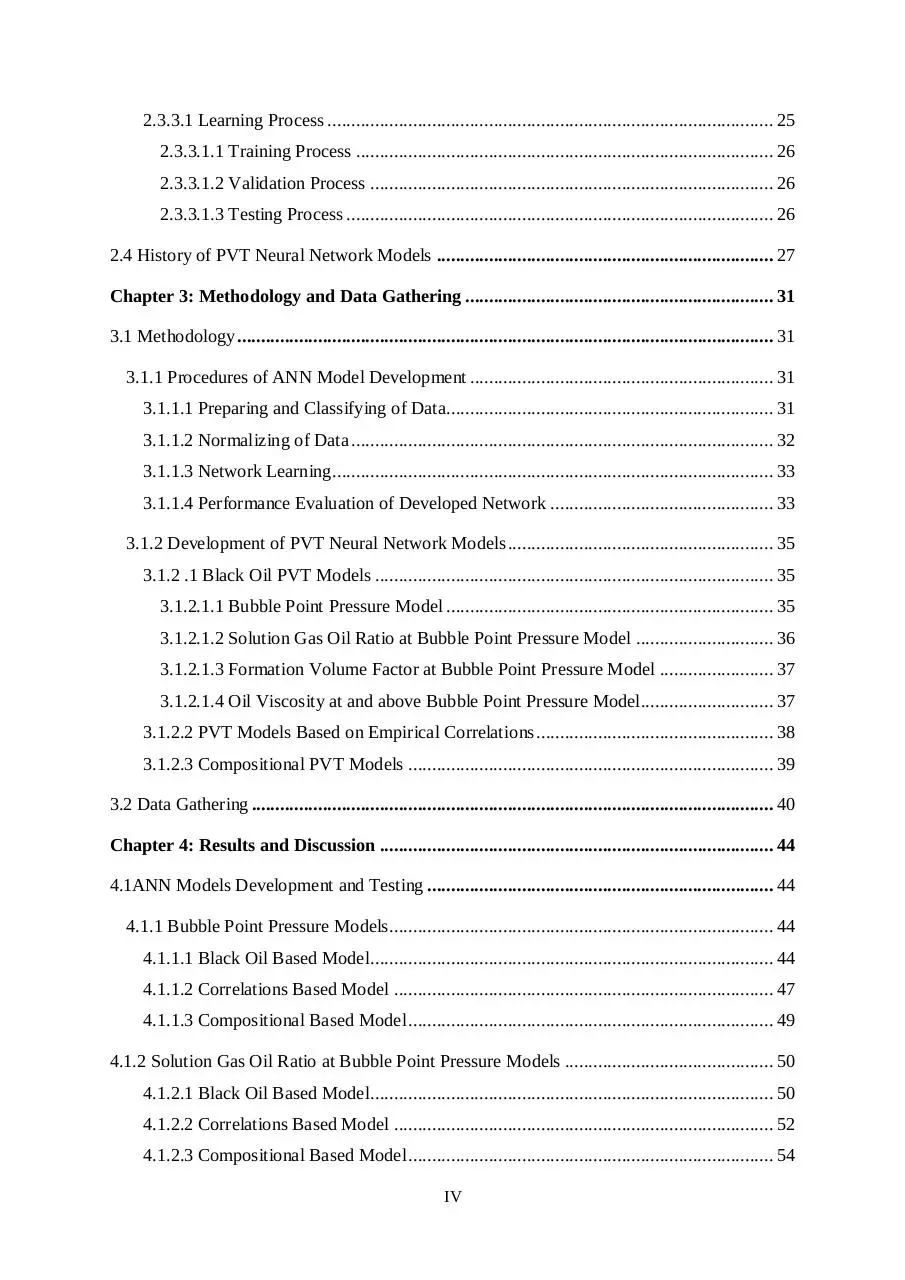master of science thesis in petroleum engineering (PDF)
File information
Author: koorosh
This PDF 1.5 document has been generated by Microsoft® Office Word 2007, and has been sent on pdf-archive.com on 28/07/2015 at 17:25, from IP address 78.39.x.x.
The current document download page has been viewed 1314 times.
File size: 1.89 MB (94 pages).
Privacy: public file





File preview
Petroleum University of Technology
Abadan Faculty of Petroleum Engineering (Shahid Tondgooyan)
Department of Petroleum Exploration Engineering
Prediction of Crude Oils PVT Properties Using
Artificial Neural Networks
Master of Science Thesis
By:
Koorosh Kazemi
Supervisors:
Jamshid Moghadasi
Siyamak Moradi
ABADAN, IRAN
September 2011
Abstract
PVT properties of reservoir fluid are very important in petroleum engineering calculations,
therefore the accuracy of the calculations depends on the exactness of PVT properties. Ideally
these properties are determined from laboratory analysis of the samples.
In some cases PVT data are not available or reliable. At these occasions, empirical
correlations are used which are developed for PVT properties estimation. Accuracy of the
correlations depends on similarity of fluid properties and fluid that used for developing
correlations, thus results of the predictions may not be accurate for new samples. Hence
Artificial Neural Network (ANN) has been applied as new technique for PVT properties
estimation of Iranian crude oils.
Feed-forward back-propagation networks with Levenberg-Marquardt training algorithm have
been used to predict bubble point pressure, solution gas oil ratio at bubble point pressure, oil
formation volume factor at bubble point pressure, and saturated and undersaturated oil
viscosity. The black oil, correlations and compositional based models have been presented for
each property based on PVT data which are collected from oil reservoirs in south west of
Iran.
The presented models have been evaluated and all of them obtained acceptable performances.
The black oil and correlations based models have been compared to empirical correlations.
These developed models outperformed correlations with highest correlation coefficients and
lowest average absolute relative errors. Iranian correlations were more appropriate than other
correlations and gave most accurate results after ANN models.
I
Acknowledgment
I would like to express my sincere appreciation to my advisor, Dr. Jamshid Moghadasi for his
guidance and encouragements. Also, I have very grateful to my advisor, Dr. Siyamak Moradi
for his advices and invaluable helps during my study.
I take this opportunity to thank my parents for their kindly supports and patient, who I always
look them for guidance.
I would like to thank my all friends who help me during this study, especially Mohammad
Reza Ramezani ,Ahmad Abolhasanzade, Reza Namdari, Masoud Vafayi, Mohammad Arab,
Ayoob Nazarpoor, Milad Fallahi, Mojtaba Izadi, Mojtaba Asoodeh, Damoon Zaboli, Akbar
Soltani, Ali Hejazi, Amin Bigdeli and Azad Mohamad Panah.
II
Table of Contents
Abstract ................................................................................................................................ I
Acknowledgment ................................................................................................................ II
Table of Contents .............................................................................................................. III
List of Figures.................................................................................................................... VI
List of Tables .................................................................................................................. VIII
Nomenclature ..................................................................................................................... X
Chapter 1: Introduction ...................................................................................................... 1
1.1 Problem Statement and Study Objectives ........................................................................ 1
1.2 Chapters Review ............................................................................................................. 2
Chapter 2 :Literature Review ............................................................................................. 3
2.1 PVT Properties and Applications ..................................................................................... 3
2.2 PVT Empirical Correlations ............................................................................................ 6
2.2.1 Bubble Point Pressure Correlations ........................................................................... 6
2.2.2 Solution Gas Oil Ratio Correlations .......................................................................... 9
2.2.3 Oil Formation Volume Factor Correlations ............................................................. 11
2.2.4 Oil Viscosity Correlations ....................................................................................... 16
2.3 Artificial Neural Networks ............................................................................................ 21
2.3.1 Artificial Neural Networks Background .................................................................. 21
2.3.2 Components of Artificial Neural Network ............................................................... 22
2.3.2.1 Neuron ............................................................................................................. 22
2.3.2.1.1 Weight and Bias ......................................................................................... 23
2.3.2.1.2 Summation Function .................................................................................. 23
2.3.2.1.3 Transfer Function ....................................................................................... 23
2.3.2.2 Layers .............................................................................................................. 24
2.3.3 Feed-Forward Back-Propagation Network .............................................................. 25
III
2.3.3.1 Learning Process .............................................................................................. 25
2.3.3.1.1 Training Process ........................................................................................ 26
2.3.3.1.2 Validation Process ..................................................................................... 26
2.3.3.1.3 Testing Process .......................................................................................... 26
2.4 History of PVT Neural Network Models ....................................................................... 27
Chapter 3: Methodology and Data Gathering ................................................................. 31
3.1 Methodology ................................................................................................................. 31
3.1.1 Procedures of ANN Model Development ................................................................ 31
3.1.1.1 Preparing and Classifying of Data..................................................................... 31
3.1.1.2 Normalizing of Data ......................................................................................... 32
3.1.1.3 Network Learning............................................................................................. 33
3.1.1.4 Performance Evaluation of Developed Network ............................................... 33
3.1.2 Development of PVT Neural Network Models ........................................................ 35
3.1.2 .1 Black Oil PVT Models .................................................................................... 35
3.1.2.1.1 Bubble Point Pressure Model ..................................................................... 35
3.1.2.1.2 Solution Gas Oil Ratio at Bubble Point Pressure Model ............................. 36
3.1.2.1.3 Formation Volume Factor at Bubble Point Pressure Model ........................ 37
3.1.2.1.4 Oil Viscosity at and above Bubble Point Pressure Model............................ 37
3.1.2.2 PVT Models Based on Empirical Correlations .................................................. 38
3.1.2.3 Compositional PVT Models ............................................................................. 39
3.2 Data Gathering .............................................................................................................. 40
Chapter 4: Results and Discussion ................................................................................... 44
4.1ANN Models Development and Testing ......................................................................... 44
4.1.1 Bubble Point Pressure Models ................................................................................. 44
4.1.1.1 Black Oil Based Model..................................................................................... 44
4.1.1.2 Correlations Based Model ................................................................................ 47
4.1.1.3 Compositional Based Model ............................................................................. 49
4.1.2 Solution Gas Oil Ratio at Bubble Point Pressure Models ............................................ 50
4.1.2.1 Black Oil Based Model..................................................................................... 50
4.1.2.2 Correlations Based Model ................................................................................ 52
4.1.2.3 Compositional Based Model ............................................................................. 54
IV
4.1.3 Formation Volume Factor at Bubble Point Pressure Models .................................... 56
4.1.3.1 Black Oil Based Model..................................................................................... 56
4.1.3.2 Correlations Based Model ................................................................................ 58
4.1.3.3 Compositional Based Model ............................................................................. 60
4.1.4 Oil Viscosity Models .............................................................................................. 62
4.1.4.1 Black Oil Based Model..................................................................................... 62
4.1.4.2 Correlations Based Model ................................................................................ 66
4.1.4.3 Compositional Based Model ............................................................................. 69
4.2 Summary of Results ...................................................................................................... 70
Chapter 5: Conclusions and Recommendations ............................................................. 73
5.1 Conclusions ................................................................................................................... 73
5.2 Recommendations ......................................................................................................... 74
References.......................................................................................................................... 76
V
List of Figures
Figures
Figure 2.1. Variations of PVT parameters versus pressure a) Solution gas oil ratio; b)
Formation volume factor; c) Viscosity................................................................................... 5
Figure 2.2. A typical neural network [53] .............................................................................. 22
Figure 2.3. Three useful types of transfer functions ............................................................. 24
Figure 2.4. The multistep operation in a neuron ................................................................... 24
Figure 3.1. Data division process ......................................................................................... 32
Figure 3.2. A typical form of black oil based model for bubble point pressure ..................... 36
Figure 3.3. A typical form of black oil based model for solution gas oil ratio at bubble point
pressure ............................................................................................................................... 36
Figure 3.4. A typical form of black oil based model for oil formation volume factor at bubble
point pressure ...................................................................................................................... 37
Figure 3.5. A typical form of black oil based model for oil viscosity at and above bubble
point pressure ………………………………………………………………..………………37
Figure 3.6. Schematic configurations of correlation based model for P b, Rsb, Bob and µo… ..38
Figure 3.7. A typical bubble point pressure compositional model ........................................ 39
Figure 4.1. Cross plots of bubble point pressure correlations and ANN black oil based model
........................................................................................................................................... 46
Figure 4.2. Cross plots of bubble point pressure correlations and ANN correlation based
model……………………………………………………………………………………...….48
Figure 4.3. Cross plots of compositional based ANN model for bubble point pressure…. ..50
Figure 4.4. Cross plots of Rsb bubble point pressure correlations and ANN black oil based
model…………………………………………………………………………………………52
Figure 4.5. Cross plots of Rsb correlations and ANN correlation based model……………..54
Figure 4.6. Cross plots of compositional based ANN model for R sb ..................................... 55
Figure 4.7. Cross plots of B ob bubble point pressure correlations and ANN black oil based
model .................................................................................................................................. 59
Figure 4.8. Cross plots of Bob correlations and ANN correlation based model ..................... 60
Figure 4.9. Cross plots of compositional based ANN model for B ob .................................... 62
Figure 4.10. Cross plots of µob correlations and ANN black oil based model ....................... 65
VI
Figure 4.11. Cross plots of µo correlations and ANN black oil based model………………..67
Figure 4.12. Cross plots of Bob correlations and ANN correlation based model.................. ..68
Figure 4.13. Cross plots of compositional based ANN model for µ o………………………..70
VII
List of Tables
Tables
Table 2.1. The origin, number and ranges of used data in bubble point pressure correlations10
Table 2.2. The origin, number and ranges of used data in solution gas oil ratio correlations..12
Table 2.3. The origin, number and ranges of used data in oil formation volume factor
correlations ......................................................................................................................... 15
Table 2.4. The origin, number and ranges of used data in dead oil viscosity correlations ..... 19
Table 2.5. The origin, number and ranges of used data in saturated oil viscosity correlations
........................................................................................................................................... 20
Table 2.6. The origin, number and ranges of used data in undersaturated oil viscosity
correlations ......................................................................................................................... 20
Table 3.1. Statistical descriptions of used data in developing of black oil and correlations
based models for Pb and Rsb ................................................................................................ 40
Table 3.2. Statistical descriptions of used data in developing of black oil and correlations
based models for Bob ........................................................................................................... 41
Table 3.3. Statistical descriptions of used data in developing of viscosity black oil and
correlations based models.................................................................................................... 41
Table 3.4. Statistical descriptions of used data in developing of Pb and R sb compositional
models ................................................................................................................................ 42
Table 3.5. Statistical descriptions of used data in developing of B ob compositional model ... 42
Table 3.6. Statistical descriptions of used data in developing of viscosity compositional
model .................................................................................................................................. 43
Table 4.1. Weights and biases of black oil based model for bubble point pressure ............... 45
Table 4.2. Bubble point pressure correlations ...................................................................... 45
Table 4.3 Statistical analyses of bubble point pressure correlations and black oil based ANN
model .................................................................................................................................. 46
Table 4.4. Weights and biases of correlation based model for bubble point pressure ............ 47
Table 4.5.Statistical analyses of bubble point pressure correlations and correlations based
ANN model......................................................................................................................... 48
Table 4.6. Weights and biases of compositional based model for bubble point pressure ....... 49
VIII
Download master of science thesis in petroleum engineering
master of science thesis in petroleum engineering.pdf (PDF, 1.89 MB)
Download PDF
Share this file on social networks
Link to this page
Permanent link
Use the permanent link to the download page to share your document on Facebook, Twitter, LinkedIn, or directly with a contact by e-Mail, Messenger, Whatsapp, Line..
Short link
Use the short link to share your document on Twitter or by text message (SMS)
HTML Code
Copy the following HTML code to share your document on a Website or Blog
QR Code to this page

This file has been shared publicly by a user of PDF Archive.
Document ID: 0000292318.